A mile-long network of secret Cold War Tube train tunnels is to be opened to the public as an attraction, after plans were approved by the City of London Corporation.
The £220 million project, which crosses the boundary into Camden and is awaiting approval by that planning committee, is expected to open in 2027 as The London Tunnels visitor attraction.
The extensive site, 32 metres underground, will also be the home of the UK’s deepest public bar (pictured).
It will be a new use for the two extra-large (7.6-metre-diameter) parallel Tube tunnels, which were built underneath Kingsway, near High Holborn, from 1940.
The plan was for them to be used as part of a new ‘high-speed’ Tube line after the war, but this never materialised.
Each tunnel is 365 metres long. Four smaller tunnels (5.1 metres in diameter), at right angles to the main ones, to provide extra space, were added in the 1950s.
Only removed from the Official Secrets Act register in 2007, the tunnels were built during the Second World War as deep-level shelters. Never used by the public, they passed to ten government departments in the latter stages of the war, housing 1,040 staff.
In 1949, the tunnels were converted into a secure telecoms exchange that was self-sufficient with its own electricity generator, water supply and air-conditioning. It included the Cold War ‘hot line’ that connected the United States and Russian presidents.
Fitted with a staff bar, canteen, two snooker tables and a tropical fish tank, the Kingsway Exchange Tunnels (as they were then called) were last used by BT in the late 1980s. However, they remained in use as a ‘back up’ Cold War bunker control room and then for document storage until the 1990s.
Put up for sale in 2008, no serious bidders emerged until fund manager Angus Murray purchased the tunnels in September 2023.
Public access will be through a refurbished office block at 38-41 Furnival Street, a small road off Kingsway.
The majority of the tunnels will house a permanent heritage display, explaining the tunnel’s wartime roles, the transatlantic cable and exchange, plus its Cold War history.
There will be a smaller temporary space for various exhibitions. Total visitor capacity will be 750 people, with pre-booked timed-entry tickets.
















Login to comment
Comments
No comments have been made yet.